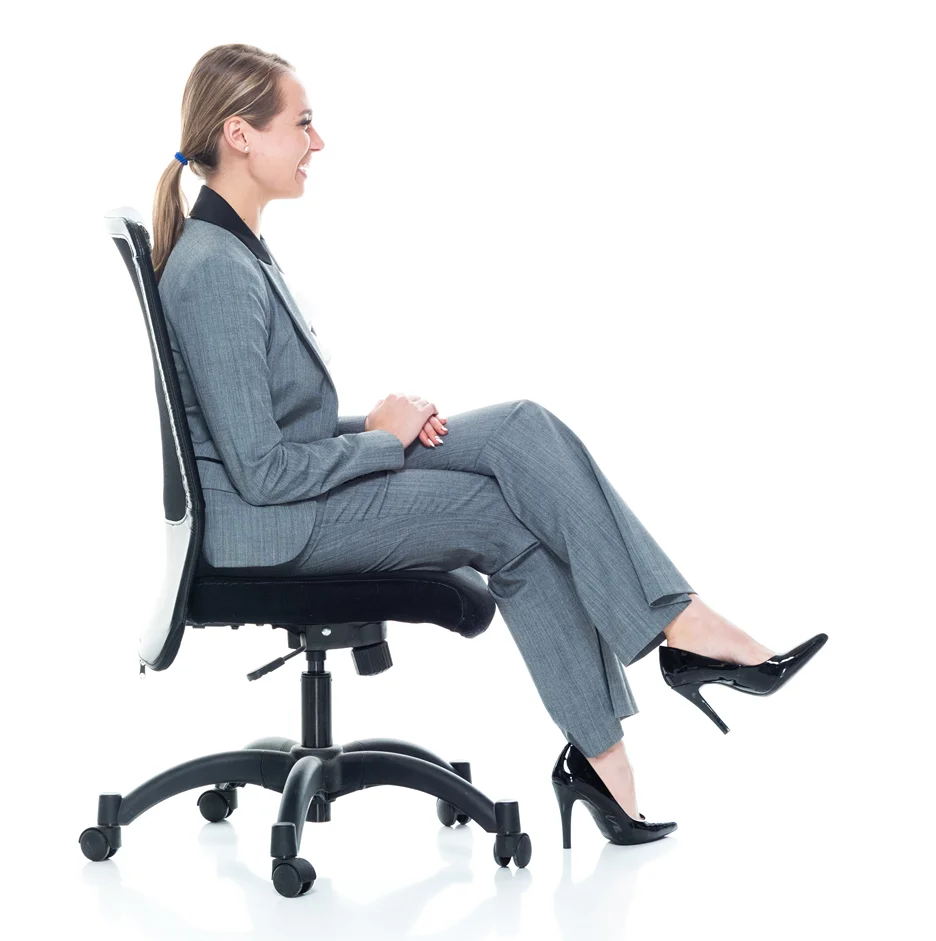How to Sit Right with Sciatica
Sciatica is characterized by pain that radiates along the path of the sciatic nerve, which branches from the lower back through the hips and buttocks and down each leg. Approximately 40% of people will develop this condition in their lifetime, and it becomes more frequent with aging. Common symptoms include tingling, numbness, and weakness in addition to sharp, shooting pain in the buttocks, thighs, calves, and feet.
Finding a comfortable sitting position can be challenging for sciatica sufferers, as certain postures can increase pressure on the sciatic nerve. However, maintaining proper spinal alignment and posture while seated is essential for managing sciatic nerve pain. The goal is to avoid slouching, bending, or hunching over, which can compress the lumbar spine and aggravate symptoms.
What Causes Sciatica Pain?
The sciatic nerves are the largest and longest nerves in the body. They originate in the lower spine and extend down each leg to the feet. Irritation of the nerve roots in the lumbar spine is the primary cause of sciatic pain.
Within the lumbar spine, spinal discs cushion and separate the vertebrae. Herniated or bulging discs can put pressure on nerve roots. Bone spurs, called osteophytes, can also compress nerve roots. In addition, tight muscles in the buttocks and legs, such as the piriformis, can pinch the sciatic nerve, triggering pain.
Sitting for extended periods with poor posture adds additional compression and strain. When the spine is hunched or bent, the spinal discs, ligaments, and nerve roots are forced closer together. This added irritation and inflammation can worsen sciatica symptoms.
Prolonged sitting can also reduce blood flow and lead to muscle imbalance, causing further sciatic nerve tension. Therefore, maintaining proper alignment when sitting is essential for sciatica sufferers. The goal is to avoid slouching and relieve pressure points.
How to Sit with Sciatica

1. Sit Up Straight
Sitting up straight is the basis for any appropriate seated position for sciatic relief. Proper spinal alignment is essential to take pressure off the sciatic nerve roots while seated.
When seated, focus on keeping the natural curve of the lumbar spine. Avoid rounding the lower back or letting it sag. The lumbar spine has an inward curve, so be mindful not to flatten it or over-arch when sitting. Keeping the spine in neutral alignment reduces strain.
Additionally, refrain from bending or hunching forward at the waist while seated, as this can compress the sciatic nerve. Avoid craning the neck forward as well. Keep the spine elongated from the tailbone through the neck.
Sitting up straight keeps body weight centered over the sitting bones rather than pressed into the sciatic nerve. It also promotes even weight distribution and reduces uneven pressure. Proper posture while sitting helps take tension off the sciatic nerve.
2. Keep Your Feet Flat on the Ground
In addition to an upright posture, keeping both feet flat on the floor helps maintain proper pelvic alignment and spinal positioning. When the feet are grounded, body weight is evenly distributed through the sitting bones and legs.
This position keeps the pelvis squarely aligned and discourages twisting postures that can irritate the sciatic nerve. The foot placement also allows the sitting bones to share body weight evenly. The nerves exit the spinal column through openings on both sides, so symmetrical posture keeps pressure balanced.
If your chair is too high, use a footrest or stool to support the feet at hip height. Having the feet grounded and knees bent at a 90-degree angle maintains proper sciatic support and spinal alignment.
3. Maintain an Open Hip Angle
In addition to foot placement, hip positioning impacts sciatic nerve tension when seated. The goal is to keep the hips open at an angle greater than 90 degrees.
Tightness in muscles like the hip flexors and piriformis can rotate the pelvis and strain the sciatic nerve. Sitting for too long in a closed hip position less than 90 degrees increases this muscular tension and pinches the sciatic nerve.
A wider seat or wedge cushion can help maintain an open hip angle greater than 90 degrees, keeping tension off the sciatic nerve. An ergonomic seat cushion discourages closed hip positioning and the tendency to slouch or hunch over.
If your current chair has a conventional seat, you can improvise with a rolled-up towel to prop open the hip angle greater than 90 degrees. Adjusting seat height may also allow you to maintain an open hip angle. The goal is to prevent the hips from rotating inward and compressing the sciatic nerve.
4. Support Your Lower Back
In addition to proper spinal alignment, providing lumbar support when sitting can help minimize sciatic nerve irritation. Lumbar support cushions improve posture by filling the space between the lower back and the back of the seat. This helps maintain the natural inward curve of the lumbar spine.
Supportive cushions can be especially beneficial for sciatica sufferers with spinal stenosis, or narrowing of the spinal canal that can further compress nerve roots. Supporting the natural curve of the lumbar spine helps open the spinal canal and take pressure off compressed nerves.
Lumbar cushions also benefit those with degenerative disc disease, disc bulges, and disc herniations that may impinge on the sciatic nerve. By supporting proper lumbar alignment, cushions can help take tension off irritated nerve roots.
Look for a seat cushion that supports the inward curve of the lower spine without pushing the body forward. Lumbar rolls add an additional layer of lower back support as well. Using both a seat cushion and lumbar roll helps maintain optimal spinal positioning.
5. Cross Your Legs
Though keeping both feet on the floor is preferable, sitting cross-legged can provide sciatic relief for some by stretching the piriformis muscle and hip flexors. The piriformis muscle runs directly over the sciatic nerve in the buttocks, so stretching it can take pressure off a pinched nerve.
You can sit cross-legged on the floor or with one ankle crossed over the opposite knee while seated in a chair. Avoid sitting for prolonged periods in these asymmetric positions to prevent muscular imbalances. Switch which ankle is crossed and monitor pain levels, adjusting your position regularly for comfort.
Sitting cross-legged helps open the hips beyond 90 degrees, minimizing sciatic nerve pinching from closed hip angles. This alternative sitting position also encourages upright posture by preventing slouching or hunching over.
While cross-legged sitting provides a hip stretch, avoid it if you have knee pain or issues. Do not force the body into uncomfortable positions. Regularly switch between symmetrical seated positions for the best sciatic pain relief.
Additional Tips for Sciatic Pain Relief While Sitting
Along with optimal posture, certain exercises, stretches, and chairs can further help alleviate sciatica symptoms while seated:
- Take regular movement breaks every 30 minutes to stand, stretch, and walk around to improve circulation and range of motion.
- Perform gentle knee raises, leg extensions, and ankle rolls to keep muscles loose while sitting. Stretch hips, hamstrings, and calves.
- Try yawning and taking deep breaths to stretch the torso muscles and encourage blood flow.
- Use ergonomic chairs or add lumbar support pillows to conventional chairs. Recliner chairs allow you to adjust angles for comfort.
- Sit towards the front of the chairs so your buttocks and thighs support your weight rather than the tailbone.
- Avoid excessive sitting whenever possible. Integrate standing desks or work surfaces to alternate positions throughout the day.
Listening to your body and adjusting your position for comfort is key. While sitting up straight is essential, occasional stretches provide added sciatic relief. Expert physical therapists can also recommend specialized exercises tailored to your abilities.
Final Thoughts

Proper sitting posture is foundational for managing sciatic nerve pain. By understanding the anatomy involved, sciatica sufferers can minimize symptoms through optimal positioning.
The keys are maintaining a neutral spinal column, keeping your feet supported to encourage symmetry, and opening the hips greater than 90 degrees. Lumbar support through ergonomic chairs and cushions also alleviates pressure on compressed nerve roots.
While additional stretches and movement breaks help, all seating positions should encourage upright spinal alignment without slouching or hunching over. By implementing these tips for ideal posture, sciatica patients can find pain relief and comfort even while seated for extended periods.
Consult with trusted specialists like those at Kaly for personalized advice and treatment plans. With expertise in chronic pain management, they can help you find the optimal solutions for sitting with sciatica. A combination of expert guidance, proper ergonomics, and stretches can dramatically improve quality of life when dealing with this common nerve issue.
